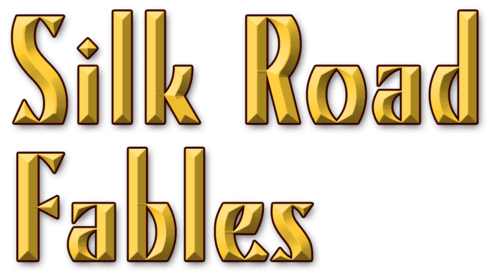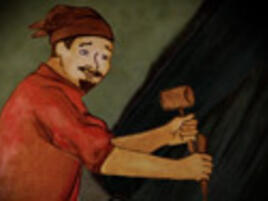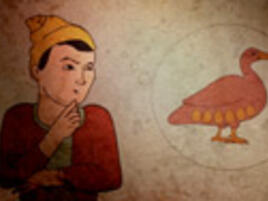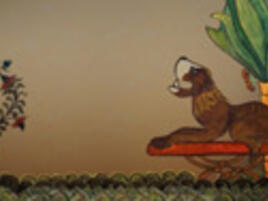SILK ROAD FABLES: The Stonecutter Who Was Never Satisfied
Title slide: An open book with a map marked in red, (left side) showing China as the origin of the tale.
On screen text: The Stonecutter Who Was Never Satisfied
[MUSIC]
NARRATOR 1: In this Chinese folktale, many wishes come true, but happiness is still hard to find.
An illustration of a Chinese landscape with mountains and trees.
NARRATOR 2: On a hot summer day in ancient China, a stonecutter worked long and hard, swinging his hammer under the blazing sun.
An animated stonecutter breaking rocks with a hammer.
NARRATOR 2: As he wiped the sweat from his brow, he thought to himself, “Surely the sun is the most powerful being in the world. I wish I could be the sun!” he cried.
An animated stonecutter with a sad expression, wiping his brow.
NARRATOR 2: A fairy heard his wish and the sun he became.
The animated stonecutter turns into the sun.
NARRATOR 2: Without wasting a second, he began to send hot sunbeams down to the land. It was wonderful to shine so bright.
Animated sun shining on mountains.
NARRATOR 2: Then a cloud came drifting along and his light grew dim. How could that be? A cloud mightier than him!
An animated cartoon cloud passes over the sun.
NARRATOR 2: Now a white fluffy cloud was what he wanted to be. That wish, too, was granted and he became a cloud, happy just to float through the blue Chinese sky.
An animated cloud floating around the sky.
NARRATOR 2: Then along came the wind. It fluttered and whirled around him and would not let him be! “If I can’t have my peace, then I’d rather blow free,” he declared. “I want to be a fierce wind!” The fairy listened and once more she offered help.
The animated cloud turning into wind and blowing across the landscape.
NARRATOR 2: Now he twisted and twirled. He teased branches and chased leaves. He dashed here and there until he blew against a rock that stood in his way. He blew as hard as he could, but the stone didn’t move. “If I were a stone,” he thought, “no one would bother me. A stone is the best thing to be!” So, the fairy turned him into a big heavy rock. He sat very still and watched time go by.
The animated wind turning into a rock.
NARRATOR 2: Until one day a group of stonecutters came his way. They pounded away at him – just doing their job.
Animated hands use chisels to hammer into the rock.
NARRATOR 2: “Please, fairy!” he begged. “Being a stone is not what I want after all. From now on I want to be nobody else but me.” One last time, the stonecutter got his wish. He picked up his hammer and went back to work under the sweltering sun.
An animated stonecutter hammering on a rock.
On screen text: The Flight of the Emperor Ming Huang and The Imperial Concubine Yang Guifei to Shu, Metropolitan Museum of Art. New York/Art Resource.
SILK ROAD FABLES: The Goose That Laid the Golden Eggs
[MUSIC]
Title slide: An open book with a map marked in red, (left side) showing Central Asia as the origin of the tale.
On screen text: The Goose That Laid the Golden Eggs
NARRATOR 1: The Goose That Laid the Golden Eggs. This Greek story is one of Aesop’s fables and was told in many lands along the Silk Road. The scenes shown here are based on a mural illustrating the tale found near Samarkand in the ruins of a merchant’s home.
A page turns, revealing an animated goose on a nest.
NARRATOR 2: There once was a man who owned a wonderful goose. Every morning, the goose laid for him a big, beautiful egg – an egg made of pure, shiny solid gold.
The goose lays a golden egg, and a hand removes it from the nest.
NARRATOR 2: Every morning, the man collected the golden egg. And little by little, egg by egg, he began to grow rich.
An animated man holding up a golden egg. He is gradually surrounded by golden eggs.
NARRATOR 2: But the man wanted more. “My goose has all those golden eggs insider her,” he kept thinking. “Why not get them all at once?”
The animated man thinking about all the golden eggs inside the goose.
NARRATOR 2: One day he couldn’t wait any longer. He grabbed the goose and killed her.
The animated man grabs a struggling goose.
[GOOSE SQUAWKING]
NARRATOR 2: But there were no eggs inside of her. “Why did I do that?” the man cried. “Now there will be no more golden eggs.”
The sad animated man transforms into an ancient illustration.
On screen text: “The fable of the Goose that Laid the Golden Eggs”, Pendjikent Murals, Room I/XXI, The State Heritage Museum, St. Petersburg, Russia
SILK ROAD FABLES: The Lion and the Hare
Title slide: Open book with a marked map on the inside cover, showing India and the Middle East as origins of the tale.
On screen text: The Lion and the Hare
[MUSIC]
NARRATOR 1: The Lion and the Hare. This tale appears in an ancient Indian book of stories. In the time of the Silk Road, the book became very popular in the Middle East after it was translated into Persian, Arabic and Hebrew.
A page turns, revealing an animated lion, roaring and being ferocious.
NARRATOR 2: In ancient times, a ferocious lion lived in the forest, killing without remorse. The other animals were terrified.
An animated fox bringing food to the lion.
NARRATOR 2: To stop the lion’s deadly hunts, some animals offered to provide him with food each day. Some animals would still die, of course, but the rest would live in peace. The lion agreed and enjoyed months of the easy life.
The animated lion jumps onto the food brought by the fox.
NARRATOR 2: One day it was the hare’s turn to present himself to the lion. Although small, the hare was very crafty. “Lion, lion,” the hare cried out as he approached. “Help me, help me! Another lion is trying to eat me. But I am to be your dinner. You must stop him!”
An animated hare (rabbit) hopping up to the lion.
NARRATOR 2: Furious that someone was trying to steal his food, the lion demanded. “Take me to the thief. I will make him pay for this mischief!”
The lion talking to the hare.
NARRATOR 2: The hare and the lion made their way through the forest, eventually reaching a deep well.
The lion looking into a stone well.
NARRATOR 2: There the lion looked down and saw his own reflection in the water.
The lion, seeing his face reflected in the well water.
NARRATOR 2: Thinking he had found the creature who tried to steal his food, the lion jumped down, ready to fight.
The lion’s feet sticking out of the well. The hare looks on.
NARRATOR 2: Alas, the lion never came out of that well and the animals lived in peace from that day on.
On screen text: “The Lion and the Hare”, Kahlila wa Dimna Manuscript, Bibliotheque Nationale de France


















 Biodiversity
Biodiversity
 Brain
Brain
 Genetics
Genetics
 Marine BiOLogy
Marine BiOLogy
 MicrobiOLogy
MicrobiOLogy
 PaleontOLogy
PaleontOLogy
 ZoOLogy
ZoOLogy
 AnthropOLogy
AnthropOLogy
 ArchaeOLogy
ArchaeOLogy
 Astronomy
Astronomy
 Climate Change
Climate Change
 Earth
Earth
 Physics
Physics
 Water
Water



